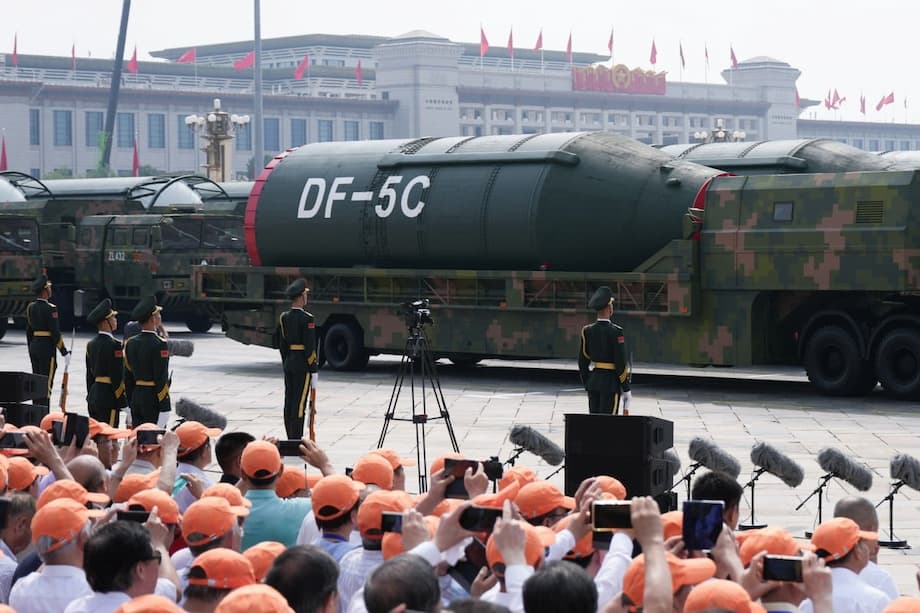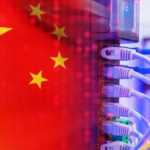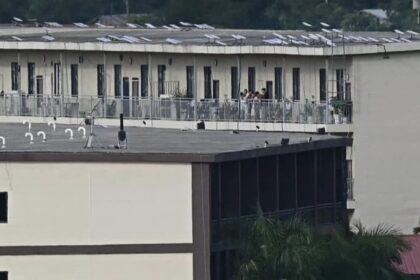A parade in Beijing and a quiet semiconductor shift
The spectacle of a military parade in Beijing can draw eyes to new missiles, drones, and armored vehicles. This year, the most consequential development was not on the parade ground. It was in a report from the Institute of Physics at the Chinese Academy of Sciences, which argued that China has matured gallium nitride semiconductor technology and is applying it across military systems at a pace rivals struggle to match. The report frames China’s export controls on key inputs not as a headline grabbing move, but as a slow pressure tactic that restrains competitors while Chinese programs scale up at home.
Gallium nitride, often shortened to GaN, is the workhorse material behind a new wave of military electronics. China produces almost all primary gallium feedstock used to make GaN devices, and it has tightened rules on exports of gallium and the related element germanium. Analysts describe the effect as a silent sanction, since it does not name specific US defense firms yet constrains their access to essential materials. The result, Chinese researchers contend, is an emerging generation gap in phased array radars and electronic warfare hardware.
In its newly released assessment, the Institute of Physics underscored how materials policy and technology progress intersect.
The Institute wrote that behind recent advances lies a hidden thread of semiconductor development, adding that China’s GaN based semiconductor technology has reached maturity.
That maturity matters because it can translate directly into longer range radars, tougher jammers, more compact guidance seekers, and better power management in combat systems. It also becomes leverage. When the main source of an input tightens the valve, programs that depend on that input slow down or get more expensive.
Why gallium nitride changes radars and missiles
GaN belongs to a class known as wide bandgap semiconductors. Compared with traditional silicon, GaN can operate at higher voltages and temperatures, handle far more power per unit area, and switch faster. Those traits make it ideal for radio frequency amplifiers and power electronics. In a radar, GaN helps each transmit and receive module push out stronger signals without overheating, then rapidly listen for faint returns. In a guidance seeker, it sustains performance against jamming while fitting into a tight nose cone.
From silicon to gallium nitride
For decades, many military radars relied on gallium arsenide or high end silicon devices. Those materials proved their worth, but GaN takes the envelope further. Engineers can build arrays with more elements in the same space and run them harder, which expands detection range, improves resistance to interference, and supports multiple modes at once. The technology also matters for power conversion on ships and aircraft, where higher efficiency reduces heat and weight, both precious in combat platforms.
The US already fields major GaN based systems, including the Navy’s AN/SPY 6 and the Marine Corps AN/TPS 80 G/ATOR. Chinese researchers and state media say China has moved GaN into production at scale across airborne early warning aircraft, air defense batteries, and fighter radars. If accurate, this suggests not only progress in device design, but also secure access to the upstream gallium that makes those devices possible.
From licensing to a targeted ban
Beijing’s first move came in July 2023, when the Commerce Ministry imposed licensing for exports of gallium and germanium. Officially it was for national security. It also followed a series of US controls on advanced chips and chipmaking tools bound for China. In December 2024, China escalated by banning exports of gallium, germanium, and antimony to the US market while tightening reviews on related items. Those minerals are central to semiconductors, infrared sensors, fiber optics, solar cells, batteries, and ammunition.
Trade and price data show the effects. Chinese gallium shipments dropped after the 2023 rules. European prices almost doubled over a year as buyers scrambled for supply. Germanium supplies tightened as well. Antimony prices surged. At the same time, China remained the dominant source of primary gallium, with US and allied buyers heavily reliant on Chinese feedstock even when buying through third countries.
In practice, the flow did not stop overnight. A review of 2024 trade data shows US imports of germanium and gallium still included material with Chinese origin that likely came through third countries. Analysts point to Belgium as a major hub for reexports of germanium. Secondary gallium production expanded in places like Canada and Germany, and Japan relied on refining and recycling to cushion the shock. The picture is a slow tightening rather than a clean cutoff, with rising costs and longer lead times spreading across the chain.
A widening military electronics gap
The Chinese Academy of Sciences report, echoed by Chinese media, argues that this material leverage has translated into faster fielding of GaN based radars, seekers, and jammers across the People’s Liberation Army. Reports highlight phased array radars on airborne early warning platforms such as the KJ 500A and advanced sets associated with the J 20 program. Some accounts also point to GaN seekers on long range air to air missiles and expanded use in air defense systems. Independent confirmation of every platform is limited, yet the trend toward broader GaN adoption looks credible given China’s industrial footprint.
The United States is no stranger to GaN. The AN/SPY 6 family is the centerpiece of a new radar architecture for destroyers. The Marines’ G/ATOR brings GaN performance to expeditionary units. Air Force and Army programs are pushing GaN for electronic warfare and missile defense. The difference, according to Chinese sources, is the rate of deployment across all services and the cost pressure induced by the gallium squeeze.
A study from the Center for Strategic and International Studies has highlighted how deep gallium runs in US defense electronics.
The analysis noted that gallium compounds are key inputs to advanced US defense systems, citing the Navy’s AN/SPY 6 radar and the Marine Corps’ AN/TPS 80 G/ATOR radar, and added that these materials are increasingly used in advanced microelectronics.
That reliance is not unique to the US. Many allied systems share similar needs. If China can secure adequate gallium for domestic GaN programs while increasing costs and uncertainty for foreign buyers, the balance in deployment speed may tilt. This is the heart of the generation gap claim. It is less about one spectacular device and more about how many arrays, seekers, and power modules reach units each year.
How Washington and allies are trying to adapt
US officials and industry leaders are pursuing parallel tracks. One is to secure more sources of gallium and germanium outside China through mining, refining, and recycling. The other is to reduce dependence by investing in next generation materials that could match or surpass GaN in certain roles.
On the materials front, the Pentagon has enlisted Raytheon through a Defense Advanced Research Projects Agency effort to develop synthetic diamond and aluminum nitride devices for high power and high frequency electronics. Those materials have wider bandgaps than GaN and could deliver even higher performance if scientists can tame production challenges and scale them to larger wafers.
Colin Whelan, who leads Advanced Technology at Raytheon, said the work represents a significant step in semiconductor technology, adding that the team is drawing on experience with similar materials in defense systems to push diamond and aluminum nitride into future sensors and communications.
Allies are moving as well. Australia, Japan, India, South Korea, and the US are coordinating on critical minerals inside groupings such as the Quad and the Indo Pacific Economic Framework. The US Export Import Bank has launched financing tools to help build overseas mining and processing nodes that are insulated from Chinese control. Japan has multiple pathways to gallium through refining, recycling, and primary production tied to zinc processing, which makes it relatively resilient. Germany has explored restarting primary gallium production, while Canada and others have increased secondary output.
Even so, the starting point is challenging. A recent CSIS assessment estimated that China controls the overwhelming share of primary gallium supply. China has also curbed exports of certain extraction technologies that competing producers need. That means market prices alone may not unlock new capacity quickly. Policymakers in Washington and partner capitals are considering stockpiles, joint procurement, and targeted investments to bridge the gap while private firms expand recycling and recovery at smelters.
The US Geological Survey has flagged the economic stakes. Its estimates suggest a complete cutoff could push gallium prices up sharply and dent US gross domestic product by more than three billion dollars when combined with a germanium ban. The US does not maintain a government stockpile of gallium. If China moved from a targeted ban to enforcement against reexports through third countries, disruptions could grow more severe until alternative sources scale.
What the supply chain data really shows
Trade data through 2024 paints a nuanced picture. Official Chinese statistics show a steep drop in gallium and germanium exports to the US after licensing began, then zero direct shipments after the targeted ban. US data still recorded imports with Chinese origin, a gap best explained by reexports through countries such as Belgium for germanium and by secondary production and reprocessing of Chinese feedstock in places like Germany and Canada for gallium. Germany had not produced primary gallium for years yet accounted for a notable share of US imports, another hint of reexport dynamics.
Price movements confirm tightening. European buyers reported gallium prices nearly doubling within a year of the initial controls. Germanium supplies became sporadic, with some industrial users warning of stockout risks. Antimony prices climbed quickly after the December 2024 action. These shifts raise costs for radar modules, infrared sensors, and precision manufacturing and can force project delays while procurement teams chase material.
The outlook hinges on two variables. The first is China’s enforcement intensity against reexports and ancillary items such as extraction resins and processing kits. The second is how fast allied producers can retrofit refineries, stand up new recovery lines at smelters, and scale recycling. Projects exist on paper and some have started, but lead times run through multiple budget cycles. Until those nodes come online, even modest changes in Chinese licensing can move prices and timelines.
Signals from Beijing and Washington
Beijing has steadily normalized the use of trade rules and export controls as tools of statecraft. It has introduced formal sanctions frameworks, asserted state ownership in strategic mineral domains, and restricted the export of certain rare earth processing technologies. These steps follow earlier informal tactics and signal a willingness to use domestic levers to shape global supply in areas where China holds advantage.
Washington has replied with tighter controls on Chinese access to advanced chips and tools, more entities on restricted lists, and a push to diversify supply chains. Allies have created early warning networks for mineral disruptions and linked logistics plans to keep critical inputs flowing during shocks.
Defense technologists underline why all this matters for the battlefield. GaN and related materials sit at the heart of radars, communications, and power electronics that define modern combat.
Dr. Fabian Villalobos, a senior engineer at Rand, put it simply: They are vital.
That clarity helps explain the urgency on both sides. China is racing to convert materials dominance into fielded systems. The US and partners are racing to broaden supply and to upgrade platforms with devices that sip power, shrug off heat, and bend radio waves with precision. The contest is measured less by a single announcement than by delivery schedules, unit counts, and how often maintenance crews swap out aging modules for GaN parts.
Key Points
- A Chinese Academy of Sciences report says China’s GaN technology has reached maturity and is being applied across military platforms.
- Beijing moved from licensing controls in 2023 to a 2024 ban on US bound exports of gallium, germanium, and antimony.
- China dominates primary gallium supply, while germanium production is also concentrated, driving price spikes and long lead times for buyers.
- US defense systems such as AN/SPY 6 and G/ATOR already use GaN, but Chinese sources claim faster and broader deployment across the PLA.
- Trade data suggests continued reexports through third countries, softening the immediate blow but adding cost and uncertainty.
- DARPA has tasked Raytheon to pursue diamond and aluminum nitride devices to reduce reliance on gallium, while allies invest in non Chinese supply.
- USGS estimates that a full cutoff could trim US GDP by roughly 3.4 billion dollars, and the US lacks a gallium stockpile.
- The next phase depends on China’s enforcement against reexports and the speed of allied projects to expand refining, recovery, and recycling.












